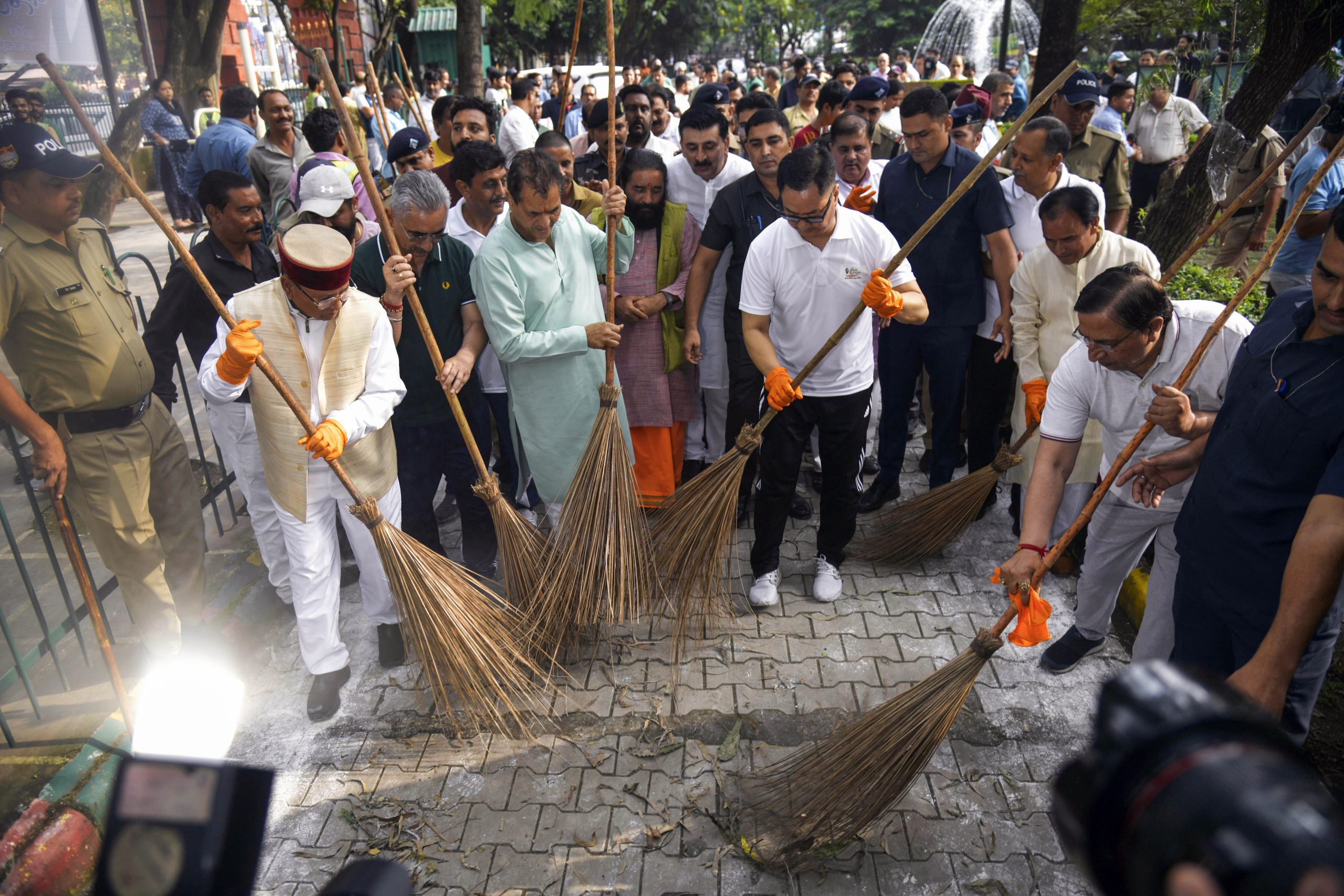Sitting beneath a neem tree, right outside his house in Dhamnar village of Madhya Pradesh, Lakhan Singh (age – 35) told me about one of his happiest memories – the birth of his son Sachin in September of 2014. However, a little further into this conversation, Lakhan’s smile quickly gave way to a tense expression. This change in mood was triggered by his memories of his son experiencing frequent cases of diarrhoea since he started walking in early 2016. He recounted days when both he and his wife used to make rounds to the local hospital. The first few instances of illness were handled by the family without any major distress. However, when they realised that these cases were repeating frequently, that was when they started to get worried. According to Lakhan, during the monsoon season of 2016, his son suffered five episodes of diarrhoea within a span of two and a half months. This prompted Lakhan to go to a doctor, begging for answers. The answer that the doctor gave Lakhan is still crystal clear in his mind even after several years. The doctor, from the conversation with the family, suspected that Sachin’s frequent episodes of diarrhoea might have primarily been caused by his coming into contact with faecal matter during their visits to a local field for defecation. However, the solution to this problem, according to the doctor, was simple – construction of a toilet in his house. However, being a daily wage earner and the sole breadwinner of his family, Lakhan did not possess the financial means to construct a toilet all by himself. He was, however, advised by his neighbour to reach out to his gram Pradhan to recommend his name for financial incentives for the construction of a toilet in his house. Once his application was filed, within 2 weeks Lakhan received a sum of ₹12,000 in his bank account. With joy once again in his voice, Lakhan said that he vividly remembers 17th November 2016, the day when the construction of the toilet in his house was finally completed. The biggest beneficiary in this case has been Sachin, who has never experienced such frequent cases of diarrhoea since.
The story of Sachin is one of hope. However, lakhs of children were not as fortunate as him. Until recently, millions of Indian children were at daily risk from diseases caused by poor sanitation. Until recently majority of the households in our villages did not have personal toilets. This meant people engaged in open defecation which resulted in outbreaks of diarrhoea due to a direct exposure of faecal matter or indirect exposure from contamination of soil and water. Frequent cases of diarrhoea also led to chronic malnutrition in many cases, a fact highlighted in the data from NFHS – 4 (2015-16) which suggested that roughly 38% of children under-fives were stunted in part due to poor sanitation and infections. A grimmer reality according to UNICEF was that nearly 1,00,000 children under five died each year in India from diarrhoea caused by unsafe water and improper sanitation. Sachin was fortunate to be born at a time where India was making major progress towards becoming open-defecation-free, sparing him from these hazards. In fact, studies show that India’s sanitation revolution has already saved countless young lives.
Swachh Bharat Mission – Origins and Nationwide Rollout
The inception of this revolution can be linked to 2nd October 2014, when Prime Minister Narendra Modi initiated the Swachh Bharat Mission (SBM) aiming for an open-defecation-free (ODF) India by 2019. He not only encouraged the public to view sanitation as a national responsibility but also demonstrated this by using a broom in public and calling on citizens in speeches to participate in a “Jan Andolan” for hygiene. The SBM adopted a two-pronged strategy for improving the state of sanitation. On the demand front, it launched extensive awareness initiatives – ranging from school events to television commercials – to encourage changes in behaviour. Officials and volunteers (called as Swachhagrahis) visited homes, raising awareness among villagers about toilet usage, cleanliness, and the health dangers associated with open defecation. From the supply side, the government provided financial aid of ₹12,000 to ensure that even the most impoverished families could construct a toilet. This blend of community-based learning and financial motivation demonstrated significant strength. Residents who previously accepted open defecation as normal started requesting toilets. Further, an innovative use of technology in the provision to track applications by an individual on an online portal or mobile app, transfer of funds for toilet construction using DBTs and verifying the status of toilet construction using geo-tagged images, ensured that the mission remained effective and efficient hence, avoiding the failure of the previous sanitation programs.
During the duration of Phase I of SBM (2014-2019), India underwent an unparalleled transformation. Over 100 million toilets for rural households were constructed nationwide, with women and children frequently, taking the lead in the inauguration events for their new latrines. Rural sanitation access surged from about 40% of households in 2014 to near universal coverage by 2019. The Swachh Bharat Mission’s success owed much to political will – with Prime Minister Modi’s constant encouragement – and its blending of patriotism, community pride, and practical support with sanitation.
Broader Benefits: From Health Gains to Women’s Safety
The impact of the Swachh Bharat Mission extends far beyond the convenience of having a toilet. First and foremost, by eliminating open defecation has meant far fewer harmful germs in the environment leading to a sharp decline in occurrences of diseases like cholera, typhoid, and diarrhoea. By 2019, the World Health Organization estimated that improved sanitation under SBM had averted over 300,000 deaths (especially from diarrheal illness and malnutrition) compared to the baseline scenario. Community health workers report seeing far fewer cases of children wracked by dehydration from diarrhoea, and hospitals note declines in water-borne disease outbreaks during monsoon season. Childhood nutrition has improved as well – with kids falling sick less often, they can absorb nutrients better. India’s child stunting rates, while still high, have been dropping faster in areas that eliminated open defecation. In economic terms, sanitation is paying dividends for rural families and the nation. When illnesses decrease, households save on medical bills and parents miss fewer work days. A UNICEF analysis found that a typical family in an ODF (open defecation free) village saved about ₹50,000 per year in health costs and productivity, thanks to better sanitation. This is a huge relief for poor families – money that might otherwise be spent treating recurrent diarrhoea or lost due to sick days can now go towards food, education, and improving livelihoods. Further, the study also highlights that every rupee invested in building toilets is yielding over four rupees in social and economic benefits – a remarkable 430% return on investment according to one independent cost-benefit study.
Perhaps the most profound change has been brought in the lives of our women and girls. For decades, the lack of a household toilet meant that women had to wait until darkness (either before sunrise or after sunset) to relieve themselves in fields or behind bushes. This was not only uncomfortable and unhealthy, but also dangerous. Countless women often faced embarrassment, harassment and even threats of sexual assault when they went out to defecate in the open. The Swachh Bharat Mission has brought a massive improvement in this aspect of daily life. With nearly every home now equipped with a latrine, women can use a toilet with privacy and security. A survey by the government found that 93% of women reported feeling safer after getting a toilet at home. No longer must they trek to isolated areas late at night, or fear for their safety and dignity while attending to a basic bodily need. Privacy has improved as well – teenage girls, for instance, no longer dread the lack of sanitation during menstruation, and older women speak of a newfound sense of self-respect. Apart from safety, having a toilet has indirect benefits for women’s empowerment: it reduces school absenteeism among girls (who previously might avoid school if no toilets were available). All these changes translate into greater dignity and quality of life.
The Swachh Bharat Mission – Grameen has been much more than a construction spree; it has been a transformative public health campaign and a social revolution. It has saved lives by the lakhs, cut medical expenses, and improved children’s growth and development. It has given rural women a sense of security and pride that was long denied to them. By coupling data-driven strategy with a people-powered movement, SBM managed to achieve what many once thought impossible – eliminate open defecation across most of rural India – and in doing so, unlocked a cascade of benefits for health, economic development, and human dignity. What began as one leader’s vision quickly became a nationwide celebration of cleanliness. India’s villages are cleaner, safer, and healthier today, and future generations like young Sachin are reaping the rewards of this cleanliness revolution.











